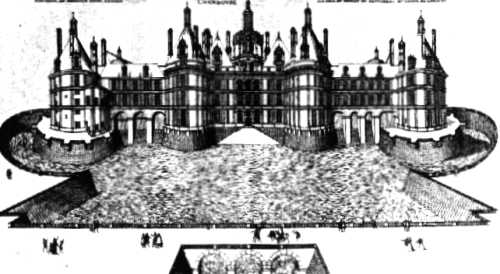

The military adventures of the French kings Charles VIII, Louis XII, and most of all, François Ier , had the effect of bringing the Italian Renaissance to France. François was especially a great patron of the arts, bringing such great Italians as Benvenuto Cellini and Leonardo da Vinci to France. Da Vinci died in the king's chateau at Amboise, which is why the Mona Lisa hangs in the Louvre. He gathered artists and architects for his grand building project at the chateau of Fontainebleu, and the synergy of Italian and French energy created a unique French Renaissance style. The Loire valley sprouted a number of gorgeous chateaux under his reign and that of Henri II.
The noteworthy sculptors of this time were Michel Colombe (1430-1512), Jean Goujon (1515-1560), and Germain Pillon (1535-1590). François Clouet (1516-1572) painted exquisite royal portraits, he and his school providing a kind of family album of the royal house for a good part of the century.
In literature, the first half of the century saw the bloom of French humanism. François Rabelais (1494-1553), a former monk, wrote biting social satires in Pantagruel (1532) and Gargantua (1534). His books also bear testimony to the importance the Renaissance placed on humanistic education. The poets Pierre de Ronsard (1524-1585) and Joachim du Bellay (1522-1560) were the leaders of La Pléiade, a group of young poets who urged the use of the French language in literature, at the same time reverting to a classical style. The first French drama was written by a member of the Pleiade --a tragedy called Cléopatra. Catherine de' Medici brought artists of the Italian Commedia del'Arte to France. She also commissioned the first full-length ballet, which was performed by her maids of honor.
Although the Protestant Reformers were originally allied with the Christian humanists, they eventually parted ways. Humanism focused on the perfectability of mankind, while the Reform focused on the great gulf between a holy God and a sinful people, who could only be saved through the grace of God and whose own efforts availed nothing. The reformer John Calvin (1509-1564) was born in Noyon in Picardy, but fled France for Geneva to avoid persecution. He and Rabelais represent complete antitheses in the intellectual spectrum of the times.
Michel Eyquem de Montaigne (1533-1592) introduced a question-and-answer technique in his Essais (1580-1588); his influence on the philosophy, style, and form of later writers such as Rousseau and the essayist Charles Lamb was marked. [Your host is very fond of subjecting his extended family to readings from Montaigne, who was practically a neighbor of his uncle's from his old home province.]
A number of important works of political theory appeared in this century. The breakdown of social structures prompted a great deal of thought on the role of the monarchy, the state, and the people. Jean Boudin's (1530-1596) Six livres de la République (1576), was an outstanding work that ultimately advocated royal absolutism, although emphasizing the mutual responsibilities of king and people. The Huguenot François Hotmanís Francogallia (1573) represented the other side of the coin: proposing an ancient Frankish constitution that superseded the rights of kings, who derived their right to rule from the consent of the people. The Huguenots made a considerable contribution to the theory of resistance in mid-century. After their candidate, Henri de Navarre, became the legitimate heir to the throne in 1589 the Huguenots became royalists and the Catholic League began to advocate the moral right to commit tyrannicide and to overthrow an unwanted king.